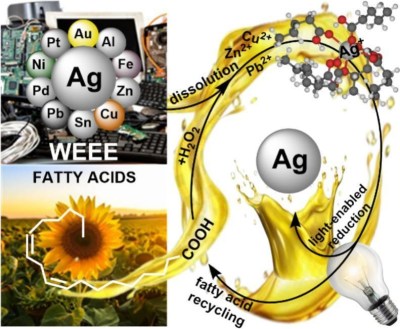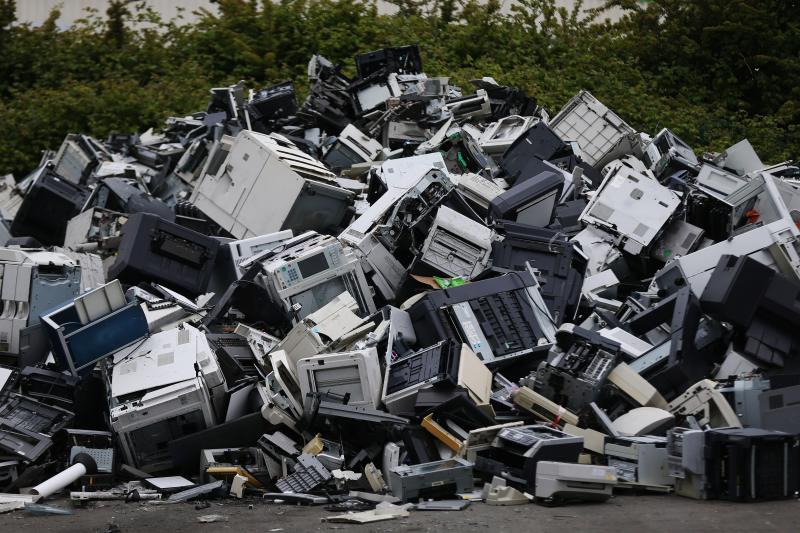As the saying goes, “if it can’t be grown, it has to be mined”– but what about all the metals that have already been wrested from the bosom of the Earth? Once used, they can be recycled– or as this paper charmingly puts it, become ore for “urban mining” techniques. The technique under discussion in the Chemical Engineering Journal is one that extracts metallic silver from e-waste using fatty acids and hydrogen peroxide.

Right now, recycling makes up about 17% of the global silver supply. As rich sources of ore dry up, and the world moves to more sustainable footing, that number can only go up. Recycling e-waste already happens, of course, but in messy, dangerous processes that are generally banned in the developed world. (Like open burning, of plastic, gross.)
This paper describes a “green” process that even the most fervant granola-munching NIMBY wouldn’t mind have in their neighborhood: hot fatty acids (AKA oil) are used as an organic solvent to dissolve metals from PCB and wire. The paper mentions sourcing the solvent from waste sunflower, safflower or canola oil. As you might imagine, most metals, silver included, are not terribly soluble in sunflower oil, but a little refining and the addition of 30% hydrogen peroxide changes that equation.
More than just Ag is picked up in this process, but the oils do select for silver over other metals. The paper presents a way to then selectively precipitate out the silver as silver oleate using ethanol and flourescent light. The oleate compound can then be easily washed and burnt to produce pure silver.
The authors of the paper take the time to demonstrate the process on a silver-plated keyboard connector, so there is proof of concept on real e-waste. Selecting for silver means leaving behind gold, however, so we’re not sure how the economics of this method will stack up.
Of course, when Hackaday talks about recycling e-waste, it’s usually more on the “reuse” part of “reduce, reuse, recycle”. After all, one man’s e-waste is another man’s parts bin–or priceless historical artifact.
Thanks to [Brian] for the tip.Your tips can be easily recycled into Hackaday posts through an environmentally-friendly process via our tipsline.
















Ok, but what happens to the slush that’s left over? Presumably the electronics would need to be ground into a more surface-available dust and mixed into a slurry for this chemical process to work. This liquid waste can be a lot harder to deal with than the more relatively solid waste you normally see.
And ask for the other metals that are leached out, but not as readily, what happens to them? If you only pull 10% as much eg. cadmium into the solution, you’ve still got a solution with a lot of cadmium in it.
Seems like having skimmed the paper they didn’t do anything but cut larger chunks into pretty large cubes and all the other metals that are dissolved remain in the liquid for the most part, and that liquid can in theory be reused to process more after the silver gets selectively precipitated.
So in theory at least you’d build up the other metals that do dissolve to a level that makes the silver extraction less and less efficient, though maybe it would also cease to be producing such pure silver. Either way at that point you have a fairly concentrated mix of these other metals in a small volume of liquid rather than huge volume of e-waste plastics you can process. Also as it seems from a skim read the gold isn’t touched by this process the waste from silver extraction is probably worth then processing that waste for gold extraction eventually.
All in all an interesting concept that I’d like to see the long term recycling projections done with.
Where did the world elope to? What did its parents have to say about it?
:) Fixed, and thanks.
lol
I’d be keen to see some statistics for silver consumption after the introduction of digital cameras. Silver being a significant component of film negatives, I know the bleach baths for colour film – where the developed silver and unexposed silver halides were removed – were targeted for recovering the silver halides.
Solar panels.
“fatty acids (AKA oil) ”
Fatty acids are not oil. Fatty acids are, well, just that: fatty acids.
Oils (as mentioned here, vegetable oils) are esters of fatty acids and glycerol.
I always worry when I read about some new industrial process that takes some input that’s human food and turns it into something that is NOT edible. Sure they are using waste sunflower oil, but increased demand will cause the price to go up. And if clean oil works better there will always be the temptation to use fresh oil . Second, even if they swear it will never happen, there’s always a way for used & contaminated oil to somehow make it back to the human food supply.
Well luckily that stuff isn’t human food in the first place, it was mass marketed as food after petroleum oil bases for paint were developed, leaving behind a massive industry of sunflower and flax and rapeseed oil production that was (until then) considered unfit for human consumption. So they just handwaved that and re-marketed it.
Get out of here, you unscientific seed oil crank.
Cool, Cool.
I express concern about profit-driven industry misdirecting resources, and I get nutrition science’s answer to the ancient aliens guy,